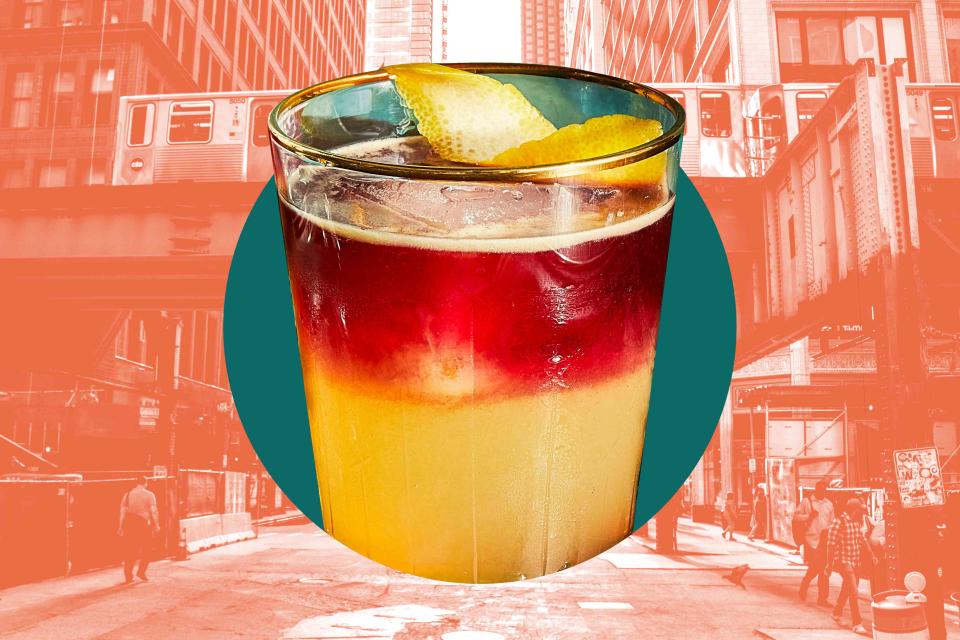Is Chicago the Real City Behind the New York Sour?
The Windy City may be able to claim this pre-Prohibition classic.

Food & Wine / PHOTO BY JENNIFER CAUSEY / FOOD STYLING BY MELISSA GRAY / PROP STYLING BY HEATHER CHADDUCK HILLEGAS / Getty Images
New York City gets plenty of credit for cocktails, and rightly so. But with many cocktail creations, credit often comes from an unreliable source.
The New York Sour fits this description. The name alone seems to imply a point of origin, or at the very least, a drink inspired by the city. These implications are incorrect, and one of the world’s most popular Whiskey Sour variations, with its iconic red wine float, is likely named a New York Sour simply because Chicago was being sloppy.
Hints of an origin
It’s thought that the New York Sour was invented in Chicago in the 1880s.
The drink emerged as a riff on the ubiquitous Whiskey Sour. One problem: nobody could agree on the name. The Continental Sour, the Brunswick Sour, and the Claret Snap were all offered as potential monikers. But the lack of a definitive name adds to the drink’s historical ambiguity.
There’s no concrete proof that someone in Chicago specifically came up with the New York Sour. There isn’t a recipe in a 19th-century cocktail book, nor is there some napkin covered with hastily scribbled drink specifications. There is, however, documented evidence that Chicagoans were drinking something that sounded an awful lot like a New York Sour before any mention of it on the East Coast.
Related: Who Really Invented the Moscow Mule and Why Is It in a Copper Mug?
Courtesy of “The Bartender,” a story printed in the Chicago Tribune on November 25, 1883, under its “Local Miscellany” column, an account captures a Chicago bartender named Tommy whipping up a handful of popular drinks.
About one-third into the column, this gem appears:
“Then the nimble liquor artist put up another large plain glass, filled a delicate oval goblet with cracked ice, and put a prescription of lemon sirup [sic], sugar, whisky, and ice in the large glass.
This mixture was also agitated in the shaker, and, after the cracked ice had been cast from the goblet, it was poured into it from the dizzy hight [sic] that was reached by the chemist’s left arm. A bottle of claret was cautiously uncorked, and about a gill of the scarlet liquid was carefully slid in on the top of the yellowish mixture in the goblet, making a pleasant-looking, red-haired drink. That was a whisky sour.”
“It’s not 100% clear that Tommy is making what we would call a New York Sour,” says Petr Balcarovsky, lead bartender of The Apparatus Room in Detroit. “The writer calls it a Whiskey Sour, but the terminology he used suggests Tommy was making a Claret Snap, which was one of the names used for a sour with a red wine float back then.”
A self-professed culinary and cocktail historian, Balcarovsky uses this clipping to deconstruct the drink’s history and to give it some semblance of a timeline. While it doesn’t attribute drink credit to Tommy or anyone else in Chicago, it does seem to place the cocktail in the Windy City well before the name New York Sour first appeared in print in 1934, within Mr. Boston Bartender’s Guide.
Still, the cocktail’s name makes it easy for customers to make incorrect assumptions about its beginnings.
“I really wish New York would at least acknowledge the shared history of the drink with Chicago somehow,” says Balcarovsky. “Doing so would tell the drink’s full story.”
A drink with staying power
Despite its mystifying origins, the New York Sour has certainly endured. This 19th-century cocktail has been popping up on more drinks menus in recent years.
Its primary draw is that it’s a very pretty drink. Its dramatic contrast of dark red and light brown turns heads and likely encourages a few extra orders when seen. Yet looks are temporary.
“You drink what you drink because of what it tastes like,” says Katie McCourt, bartender at The Hoxton in Chicago. “Besides, the second a guest sips or swirls the drink in their glass, the visual is going to get messed up.”
Both McCourt and Barochovsky prefer using a heavier, fruit-forward wine red like a Cabernet Sauvignon or a Bordeaux blend.
“It doesn’t need to be the absolute best wine,” says McCourt. “On a scale of one to five, a wine that’s 3.5 will work well.”
Both bartenders also lean toward using rye instead of bourbon, as the former’s spicy notes provide a contrast to the wine’s fruitiness better than bourbon’s sweeter tendencies. This complex interplay between wine and spirit makes it a delightful, indulgent cocktail that offers much more than visual appeal.
While the drink’s origin story is assumed, its long-lasting appeal is not a mystery.
For more Food & Wine news, make sure to sign up for our newsletter!
Read the original article on Food & Wine.


